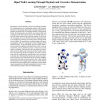114
click to vote
AAAI
2010
14 years 11 months ago
2010
We consider the problem of manipulating elections via cloning candidates. In our model, a manipulator can replace each candidate c by one or more clones, i.e., new candidates that...
AAAI
2010
14 years 11 months ago
2010
Different solvers for computationally difficult problems such as satisfiability (SAT) perform best on different instances. Algorithm portfolios exploit this phenomenon by predicti...
107
click to vote
AAAI
2010
14 years 12 months ago
2010
hey generalize these factors to the abstract concepts of ability, integrity, and benevolence. This model does not use probabilistic decision theory. Other SCM trust factors have be...
AAAI
2010
14 years 12 months ago
2010
Most frameworks for utility elicitation assume a predefined set of features over which user preferences are expressed. We consider utility elicitation in the presence of subjecti...
AAAI
2010
15 years 1 months ago
2010
Developing a robust, flexible, closed-loop walking algorithm for a humanoid robot is a challenging task due to the complex dynamics of the general biped walk. Common analytical ap...
116
click to vote
AAAI
2010
15 years 1 months ago
2010
The goal of testing is to discriminate between multiple hypotheses about a system--for example, different fault diagnoses--by applying input patterns and verifying or falsifying t...
AAAI
2010
15 years 1 months ago
2010
Many computational problems in game theory, such as finding Nash equilibria, are algorithmically hard to solve. This limitation forces analysts to limit attention to restricted su...
103
Voted
AAAI
2010
15 years 1 months ago
2010
When merging belief sets from different agents, the result is normally a consistent belief set in which the inconsistency between the original sources is not represented. As proba...
AAAI
2010
15 years 1 months ago
2010
An optimization variant of a problem of path planning for multiple robots is addressed in this work. The task is to find spatial-temporal path for each robot of a group of robots ...
53
Voted
AAAI
2010
15 years 1 months ago
2010






